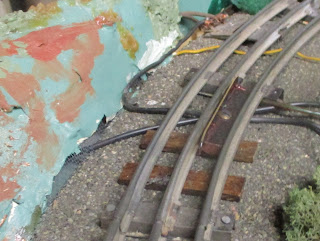Log Unloading Car
In the S gauge line, the 715 Army Unloading Car, 716 Dump Car, and 718 Mail Car are all taken over directly from O gauge operating cars. Why not the 717 Log Unloading Car? It looks as though it should have been in the O gauge catalog, but it wasn't. So I fixed that, using a damaged S gauge car. It needs a new number, probably 475, but I haven't got around to it yet.
The original system for controlling things like the Block Signal has some problems. If you follow the wiring diagrams, the signal is lit by track power, so it goes dark whenever the transformer is turned off. And the signal is controlled by the 577 contact strip, which can only be installed on a straight section and is activated by every wheel on the train. On a small layout like mine, there isn't much straight track. And I worried about burning out the operating coils if the signal is being constantly activated. So here's a solution, although it's nothing like anything Gilbert put out.
A brass strip is mounted to a wood block close to the center rail. When the pickup shoes on the locomotive pass over it, the strip is activated, thus setting the signal. The strip is short enough that one shoe is always on the rail. And as you can see, it works fine on curved track. As a result, the Block Signal works reliably without burning out.
Track Contact
The original system for controlling things like the Block Signal has some problems. If you follow the wiring diagrams, the signal is lit by track power, so it goes dark whenever the transformer is turned off. And the signal is controlled by the 577 contact strip, which can only be installed on a straight section and is activated by every wheel on the train. On a small layout like mine, there isn't much straight track. And I worried about burning out the operating coils if the signal is being constantly activated. So here's a solution, although it's nothing like anything Gilbert put out.
A brass strip is mounted to a wood block close to the center rail. When the pickup shoes on the locomotive pass over it, the strip is activated, thus setting the signal. The strip is short enough that one shoe is always on the rail. And as you can see, it works fine on curved track. As a result, the Block Signal works reliably without burning out.
Frank's Diner
This was made from the body of a derelict AF 404 coach, for my son when he was young. It's had several paint schemes over the years. While this type of Chicago car is a pretty poor model of a railroad coach, it serves just fine as a roadside diner!
Wind-up Zephyr
I also have two or three Chicago O gauge trains. This is one of them.
Salt Lake Bridge
For many years Chicago Flyer produced these wooden bridges, in varying sizes but the same basic design. One of them was donated to IRM, and I decided to make a replica, since it's a pretty simple structure. I took measurements and pictures at the Museum, and built it at home.
The brass plate was the one thing I was unable to reproduce:
But everything else went together easily:












No comments:
Post a Comment